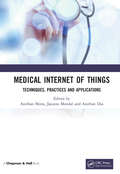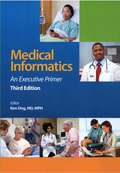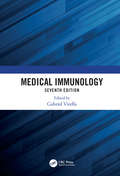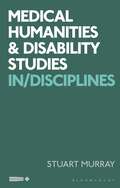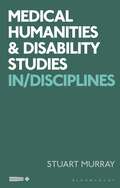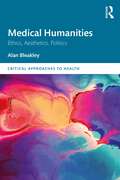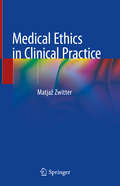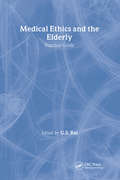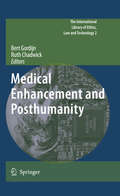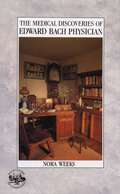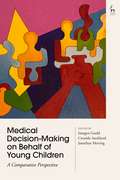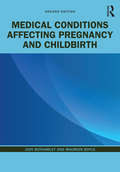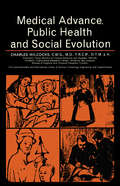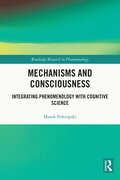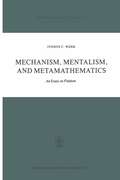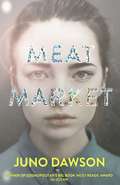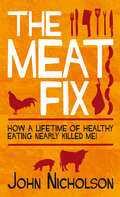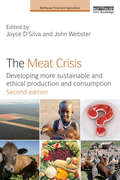- Table View
- List View
Medical Internet of Things: Techniques, Practices and Applications
by Anirban MitraIn recent years, the Medical Internet of Things (MIoT) has emerged as one of the most helpful technological gifts to mankind. With the incredible development in data science, big data technologies, IoT and embedded systems, it is now possible to collect a huge amount of sensitive and personal data, compile it and store it through cloud or edge computing techniques. However, important concerns remain about security and privacy, the preservation of sensitive and personal data, and the efficient transfer, storage and processing of MIoT-based data. Medical Internet of Things: Techniques, Practices and Applications is an attempt to explore new ideas and novel techniques in the area of MIoT. The book is composed of fifteen chapters discussing basic concepts, issues, challenges, case studies and applications in MIoT. This book offers novel advances and applications of MIoT in a precise and clear manner to the research community to achieve in-depth knowledge in the field. This book will help those interested in the field as well as researchers to gain insight into different concepts and their importance in multifaceted applications of real life. This has been done to make the book more flexible and to stimulate further interest in the topic. Features: A systematic overview of concepts in Medical Internet of Things (MIoT) is included. Recent research and some pointers on future advancements in MIoT are discussed. Examples and case studies are included. It is written in an easy-to-understand style with the help of numerous figures and datasets. This book serves as a reference book for scientific investigators who are interested in working on MIoT, as well as researchers developing methodology in this field. It may also be used as a textbook for postgraduate-level courses in computer science or information technology.
Medical Internet of Things: Techniques, Practices and Applications
by Anirban Mitra Jayanta Mondal Anirban DasIn recent years, the Medical Internet of Things (MIoT) has emerged as one of the most helpful technological gifts to mankind. With the incredible development in data science, big data technologies, IoT and embedded systems, it is now possible to collect a huge amount of sensitive and personal data, compile it and store it through cloud or edge computing techniques. However, important concerns remain about security and privacy, the preservation of sensitive and personal data, and the efficient transfer, storage and processing of MIoT-based data. Medical Internet of Things: Techniques, Practices and Applications is an attempt to explore new ideas and novel techniques in the area of MIoT. The book is composed of fifteen chapters discussing basic concepts, issues, challenges, case studies and applications in MIoT. This book offers novel advances and applications of MIoT in a precise and clear manner to the research community to achieve in-depth knowledge in the field. This book will help those interested in the field as well as researchers to gain insight into different concepts and their importance in multifaceted applications of real life. This has been done to make the book more flexible and to stimulate further interest in the topic. Features: A systematic overview of concepts in Medical Internet of Things (MIoT) is included. Recent research and some pointers on future advancements in MIoT are discussed. Examples and case studies are included. It is written in an easy-to-understand style with the help of numerous figures and datasets. This book serves as a reference book for scientific investigators who are interested in working on MIoT, as well as researchers developing methodology in this field. It may also be used as a textbook for postgraduate-level courses in computer science or information technology.
Medical Informatics: An Executive Primer, Third Edition
by William N. Kelly Kenneth R. OngThis third edition of HIMSS' award-winning, bestseller explores how clinicians, patients, and health IT stakeholders are collaborating to support high-value care through health IT. Medical Informatics: An Executive Primer continues to explore information technologies applied in hospital settings, at the physician's office and in patients' homes to
Medical Immunology, 7th Edition
by Gabriel VirellaThis seventh edition of Medical Immunology, now in a full-color presentation, continues to provide a succinct clinical review of the human response to infection while being firmly grounded in science. The authors, distinguished and experienced educators, have been able to anticipate readers’ conceptual challenges and use illustrations, diagrams, and algorithms throughout to simplify complex concepts. With an emphasis on clinical applications, methodological advances, immunological diseases, and innovative interventions, this tried and true guide navigates readers through state-of-the-sciences technologies and demonstrates their implementation in the day-to-day clinical practice of immunology. Key Features Stresses both the basic scientific concepts and clinical correlations to medical practice. Progresses logically from normal immune function to abnormalities and clinical diseases. Reviews the diagnosis, pathogenesis, and management of autoimmune diseases in a concise, manageable and visual manner Continues to be the only current medically-focused immunology text available Provides a succinct review of human response to infection with a focus on diagnostic and clinical immunology
Medical Immunology, 7th Edition
by Gabriel VirellaThis seventh edition of Medical Immunology, now in a full-color presentation, continues to provide a succinct clinical review of the human response to infection while being firmly grounded in science. The authors, distinguished and experienced educators, have been able to anticipate readers’ conceptual challenges and use illustrations, diagrams, and algorithms throughout to simplify complex concepts. With an emphasis on clinical applications, methodological advances, immunological diseases, and innovative interventions, this tried and true guide navigates readers through state-of-the-sciences technologies and demonstrates their implementation in the day-to-day clinical practice of immunology. Key Features Stresses both the basic scientific concepts and clinical correlations to medical practice. Progresses logically from normal immune function to abnormalities and clinical diseases. Reviews the diagnosis, pathogenesis, and management of autoimmune diseases in a concise, manageable and visual manner Continues to be the only current medically-focused immunology text available Provides a succinct review of human response to infection with a focus on diagnostic and clinical immunology
Medical Humanities and Disability Studies: In/Disciplines (Critical Interventions in the Medical and Health Humanities)
by Stuart MurrayMedical humanities and disability studies are disciplines at the cutting edge of innovative critical work in the study of health and disability, but to date there has been no book-length examination of the relationship between the two. Although each has emerged from different heritages, they share many features, from discussing the complexities of embodiment, identifying processes of exclusion and championing user participation, to a commitment to new forms of critical writing. In/Disciplines explores the connections between the two disciplines in detail. It presents a series of provocations about how they interact, the forms their practice take, and their strengths and weaknesses as working methods. With a focus on life stories that give accounts of health and disability experiences, it mixes creative and critical writing in an accessible manner aimed at a wide audience in both Medical Humanities and Disability Studies, and across new humanities more widely. The book asserts that both disciplines need to evaluate and challenge core assumptions if they are to remain critically relevant in the evolving study of social and cultural understanding of health and disability.
Medical Humanities and Disability Studies: In/Disciplines (Critical Interventions in the Medical and Health Humanities)
by Stuart MurrayMedical humanities and disability studies are disciplines at the cutting edge of innovative critical work in the study of health and disability, but to date there has been no book-length examination of the relationship between the two. Although each has emerged from different heritages, they share many features, from discussing the complexities of embodiment, identifying processes of exclusion and championing user participation, to a commitment to new forms of critical writing. In/Disciplines explores the connections between the two disciplines in detail. It presents a series of provocations about how they interact, the forms their practice take, and their strengths and weaknesses as working methods. With a focus on life stories that give accounts of health and disability experiences, it mixes creative and critical writing in an accessible manner aimed at a wide audience in both Medical Humanities and Disability Studies, and across new humanities more widely. The book asserts that both disciplines need to evaluate and challenge core assumptions if they are to remain critically relevant in the evolving study of social and cultural understanding of health and disability.
Medical Humanities: Ethics, Aesthetics, Politics (Critical Approaches to Health)
by Alan BleakleyThis ground-breaking book sets out a fresh vision for a future medical education by providing a radical reconceptualisation of the purposes of medical humanities through a lens of critical health psychology and liberatory pedagogy. The medical humanities are conceived as translational media through which reductive, instrumental biomedicine can be raised in quality, intensity, and complexity by embracing ethical, aesthetic, political, and transcendental values. This translation occurs through innovative use of metaphor. A note of caution is offered – that the medical humanities too can be instrumental and reductive if not framed well. Drawing on major theorists such as Michel Foucault and Jacques Rancière and bringing together insights from diverse but inter-related fields, Bleakley focuses on the "ills" of contemporary biomedicine and medical education, and the need for reconceptualisation, which – it is argued – the translational medical humanities have the potential to accomplish. Current instrumental approaches to medical humanities, embracing communication skills training and narrative-based medicine, have failed to address the chronic symptoms suffered by medicine. These include resort to closed, functional systems thinking rather than embracing dynamic, complex, open, and adaptive systems thinking; lack of democratic habits in medical culture, compromising patient safety and care; the production of insensibility rather than deepening of sensibility in medical education; a lack of attention to ethics, aesthetics, and politics where the instrumental is privileged; and a lack of critical reflexivity in revisioning habitual practices. Through persuasive argument, Bleakley sets out a more radical manifesto for the role the arts and humanities might play in medical/healthcare education and offers a new approach based on curriculum process rather than syllabus content, to recuperate aesthetic sensibilities, discernment, and affect in medicine. The book will appeal to medical and healthcare educators, medical and health humanities scholars, engaged clinicians, social scientists drawing on critical theory, and arts and humanities practitioners engaging with medical and healthcare themes.
Medical Humanities: Ethics, Aesthetics, Politics (Critical Approaches to Health)
by Alan BleakleyThis ground-breaking book sets out a fresh vision for a future medical education by providing a radical reconceptualisation of the purposes of medical humanities through a lens of critical health psychology and liberatory pedagogy. The medical humanities are conceived as translational media through which reductive, instrumental biomedicine can be raised in quality, intensity, and complexity by embracing ethical, aesthetic, political, and transcendental values. This translation occurs through innovative use of metaphor. A note of caution is offered – that the medical humanities too can be instrumental and reductive if not framed well. Drawing on major theorists such as Michel Foucault and Jacques Rancière and bringing together insights from diverse but inter-related fields, Bleakley focuses on the "ills" of contemporary biomedicine and medical education, and the need for reconceptualisation, which – it is argued – the translational medical humanities have the potential to accomplish. Current instrumental approaches to medical humanities, embracing communication skills training and narrative-based medicine, have failed to address the chronic symptoms suffered by medicine. These include resort to closed, functional systems thinking rather than embracing dynamic, complex, open, and adaptive systems thinking; lack of democratic habits in medical culture, compromising patient safety and care; the production of insensibility rather than deepening of sensibility in medical education; a lack of attention to ethics, aesthetics, and politics where the instrumental is privileged; and a lack of critical reflexivity in revisioning habitual practices. Through persuasive argument, Bleakley sets out a more radical manifesto for the role the arts and humanities might play in medical/healthcare education and offers a new approach based on curriculum process rather than syllabus content, to recuperate aesthetic sensibilities, discernment, and affect in medicine. The book will appeal to medical and healthcare educators, medical and health humanities scholars, engaged clinicians, social scientists drawing on critical theory, and arts and humanities practitioners engaging with medical and healthcare themes.
Medical Ethics in Clinical Practice
by Matjaž ZwitterThis book discusses medicine from an ethical perspective, whereas books on medical ethics more commonly present ethics from a bio-medical standpoint. The book is divided into 23 chapters. The introductory chapters present some basic concepts of medical ethics, such as the relation between the legal system and ethics, ethical documents, ethical theories, and ethical analysis. The following chapters address issues of importance in all fields of medicine: respecting autonomy, communication, relations within a healthcare team, professional malpractice, limited resources, and the portrait of a physician. In turn, the third part of the book focuses on ethical aspects in a broad range of medical activities – preventive medicine, human reproduction, genetics, pediatrics, intensive care, palliative medicine, clinical research, unproven methods in diagnostics and treatment, and the role of physicians who aren’t directly responsible for patient care. The last part presents students’ seminars with case stories. The book offers a valuable resource for physicians of all specialties, students of medicine, professionals, and students from other fields devoted to human health, journalists, and general readers with an interest in medicine.
Medical Ethics and the Elderly: practical guide
by Gurcharan S RaiThis concise, introductory handbook discusses the basic principles of medical ethics, and includes practical, realistic guidance on how to evaluate and manage common ethical problems, focusing on the care of elderly patients Typical scenarios faced in clinical practice, such as issues of mental capacity and consent, resuscitation, near death decisions, quality of life, and health care expenditure, are discussed
Medical Ethics and the Elderly: practical guide
by Gurcharan S RaiThis concise, introductory handbook discusses the basic principles of medical ethics, and includes practical, realistic guidance on how to evaluate and manage common ethical problems, focusing on the care of elderly patients Typical scenarios faced in clinical practice, such as issues of mental capacity and consent, resuscitation, near death decisions, quality of life, and health care expenditure, are discussed
Medical Enhancement and Posthumanity (The International Library of Ethics, Law and Technology #2)
by Bert Gordijn Ruth ChadwickAs we are increasingly using new technologies to change ourselves beyond therapy and in accordance with our own desires, understanding the challenges of human enhancement has become one of the most urgent topics of the current age. This volume contributes to such an understanding by critically examining the pros and cons of our growing ability to shape human nature through technological advancements. The authors undertake careful analyses of decisive questions that will confront society as enhancement interventions using bio-, info-, neuro- and nanotechnologies become widespread in the years to come. They provide the reader with the conceptual tools necessary to address such questions fruitfully. What makes the book especially attractive is the combination of conceptual, historical and ethical approaches, rendering it highly original. In addition, the well-balanced structure allows both favourable and critical views to be voiced. Moreover, the work has a crystal clear structure. As a consequence, the book is accessible to a broad academic audience. The issues raised are of interest to a wide reflective public concerned about science and ethics, as well as to students, academics and professionals in areas such as philosophy, applied ethics, bioethics, medicine and health management.
The Medical Discoveries Of Edward Bach Physician
by Nora WeeksIn 1912 Edward Bach qualified as a medical doctor and embarked upon a career which not only had a profound effect on medical science, but brought to ordinary people the world over, a simple, safe and effective system of healing.Dr. Bach made a detailed study of bacteriology, immunology and homeopathy and found a clear connection between chronic disease and negative mental attitudes. It was the relationship between mind and body which formed the basis of his further research and as he became increasingly convinced that emotional harmony was the key to good health, he was determined to find a simple, non-invasive and harmless method of healing which could be used safely by everyone.The Medical Discoveries of Edward Bach tells how Dr. Bach's work developed, from his childhood hopes and dreams of a healthy society, to the discovery of a complete system of 38 natural remedies which address all aspects of human nature, emotional outlook and personality. Edward Bach was an eminent physician whose remarkable contribution to medicine, healing and humanity has yet to be fully realised.
Medical Decision-Making on Behalf of Young Children: A Comparative Perspective
by Imogen Goold, Cressida Auckland and Jonathan HerringIn the wake of the Charlie Gard and Alfie Evans cases, a wide-ranging international conversation was started regarding alternative thresholds for intervention and the different balances that can be made in weighing up the rights and interests of the child, the parent's rights and responsibilities and the role of medical professionals and the courts. This collection provides a comparative perspective on these issues by bringing together analysis from a range of jurisdictions across Europe, North and South America, Africa and Asia. Contextualising the differences and similarities, and drawing out the cultural and social values that inform the approach in different countries, this volume is highly valuable to scholars across jurisdictions, not only to inform their own local debate on how best to navigate such cases, but also to foster inter-jurisdictional debate on the issues. The book brings together commentators from the fields of law, medical ethics, and clinical medicine across the world, actively drawing on the view from the clinic as well as philosophical, legal and sociological perspectives on the crucial question of who should decide about the fate of a child suffering from a serious illness. In doing so, the collection offers comprehensive treatment of the key questions around whether the current best interests approach is still appropriate, and if not, what the alternatives are. It engages head-on with the concerns seen in both the academic and popular literature that there is a need to reconsider the orthodoxy in this area.
Medical Decision-Making on Behalf of Young Children: A Comparative Perspective
In the wake of the Charlie Gard and Alfie Evans cases, a wide-ranging international conversation was started regarding alternative thresholds for intervention and the different balances that can be made in weighing up the rights and interests of the child, the parent's rights and responsibilities and the role of medical professionals and the courts. This collection provides a comparative perspective on these issues by bringing together analysis from a range of jurisdictions across Europe, North and South America, Africa and Asia. Contextualising the differences and similarities, and drawing out the cultural and social values that inform the approach in different countries, this volume is highly valuable to scholars across jurisdictions, not only to inform their own local debate on how best to navigate such cases, but also to foster inter-jurisdictional debate on the issues. The book brings together commentators from the fields of law, medical ethics, and clinical medicine across the world, actively drawing on the view from the clinic as well as philosophical, legal and sociological perspectives on the crucial question of who should decide about the fate of a child suffering from a serious illness. In doing so, the collection offers comprehensive treatment of the key questions around whether the current best interests approach is still appropriate, and if not, what the alternatives are. It engages head-on with the concerns seen in both the academic and popular literature that there is a need to reconsider the orthodoxy in this area.
Medical Conditions Affecting Pregnancy and Childbirth
by Judy Bothamley Maureen BoyleMidwives are encountering more and more women whose pregnancies are complicated by medical conditions, including cardiac disease, obesity and diabetes. This new edition is completely up-to-date and offers highly practical solutions for everyday midwifery practice, acknowledging the importance of promoting normality where possible. This text includes physiology, explanations of conditions and principles of care for preconception, pregnancy, labour, birth and the postnatal period. Each chapter brings together the basic knowledge of a condition and how it changes during pregnancy in an integrated and accessible way, including a new chapter dedicated to obesity. Explanations of laboratory tests, diagnostic tests, common drugs and illustrative colour pictures are included in relevant chapters. Medical Conditions Affecting Pregnancy and Childbirth is a vital guide for student midwives, as well as a useful reference for practising midwives.
Medical Conditions Affecting Pregnancy and Childbirth
by Judy Bothamley Maureen BoyleMidwives are encountering more and more women whose pregnancies are complicated by medical conditions, including cardiac disease, obesity and diabetes. This new edition is completely up-to-date and offers highly practical solutions for everyday midwifery practice, acknowledging the importance of promoting normality where possible. This text includes physiology, explanations of conditions and principles of care for preconception, pregnancy, labour, birth and the postnatal period. Each chapter brings together the basic knowledge of a condition and how it changes during pregnancy in an integrated and accessible way, including a new chapter dedicated to obesity. Explanations of laboratory tests, diagnostic tests, common drugs and illustrative colour pictures are included in relevant chapters. Medical Conditions Affecting Pregnancy and Childbirth is a vital guide for student midwives, as well as a useful reference for practising midwives.
Medical Advance, Public Health and Social Evolution: The Commonwealth and International Library: Liberal Studies Division
by Charles WilcocksMedical Advance, Public Health and Social Evolution is an attempt to relate medical progress to the intellectual climate of the various broad periods of history, and to the social changes which took place in those periods and which influenced—and were influenced by—medical progress. Since the intellectual developments and historical events which have impinged upon medical progress have occurred in the setting of history, it has therefore been convenient to divide the book into chapters with a historical basis. The book begins with discussions of Greek and Roman life and medicine; Indian and Persian life and medicine; the Middle Ages; and the Renaissance and the resuscitation of science; and the sixteenth, seventeenth, and eighteenth centuries. Separate chapters then deal with the development of hygiene; the bacteriological era; bacteriological control of food and water; and disease transmission by arthropods. Subsequent chapters cover drugs, antibiotics, hormones, and anesthetics; occupational medicine; degenerative diseases, cancer, radiology, and medical genetics; psychological medicine; and statistical methods and experiments on man and animals.
Mechanisms and Consciousness: Integrating Phenomenology with Cognitive Science (Routledge Research in Phenomenology)
by Marek PokropskiThis book develops a new approach to naturalizing phenomenology. The author proposes to integrate phenomenology with the mechanistic framework that offers new methodological perspectives for studying complex mental phenomena such as consciousness. While mechanistic explanatory models are widely applied in cognitive science, their approach to describing subjective phenomena is limited. The author argues that phenomenology can fill this gap. He proposes two novel ways of integrating phenomenology and mechanism. First, he presents a new reading of phenomenological analyses as functional analyses. Such functional phenomenology delivers a functional sketch of a target system and provides constraints on the space of possible mechanisms. Second, he develops the neurophenomenological approach in the direction of dynamic modeling of experience. He shows that neurophenomenology can deliver dynamical constraints on mechanistic models and thus inform the search for an underlying mechanism. Mechanisms and Consciousness will be of interest to scholars and advanced students working in phenomenology, philosophy of mind, and the cognitive sciences.
Mechanisms and Consciousness: Integrating Phenomenology with Cognitive Science (Routledge Research in Phenomenology)
by Marek PokropskiThis book develops a new approach to naturalizing phenomenology. The author proposes to integrate phenomenology with the mechanistic framework that offers new methodological perspectives for studying complex mental phenomena such as consciousness. While mechanistic explanatory models are widely applied in cognitive science, their approach to describing subjective phenomena is limited. The author argues that phenomenology can fill this gap. He proposes two novel ways of integrating phenomenology and mechanism. First, he presents a new reading of phenomenological analyses as functional analyses. Such functional phenomenology delivers a functional sketch of a target system and provides constraints on the space of possible mechanisms. Second, he develops the neurophenomenological approach in the direction of dynamic modeling of experience. He shows that neurophenomenology can deliver dynamical constraints on mechanistic models and thus inform the search for an underlying mechanism. Mechanisms and Consciousness will be of interest to scholars and advanced students working in phenomenology, philosophy of mind, and the cognitive sciences.
Mechanism, Mentalism and Metamathematics: An Essay on Finitism (Synthese Library #137)
by J. WebbThis book grew out of a graduate student paper [261] in which I set down some criticisms of J. R. Lucas' attempt to refute mechanism by means of G6del's theorem. I had made several such abortive attempts myself and had become familiar with their pitfalls, and especially with the double edged nature of incompleteness arguments. My original idea was to model the refutation of mechanism on the almost universally accepted G6delian refutation of Hilbert's formalism, but I kept getting stuck on questions of mathematical philosophy which I found myself having to beg. A thorough study of the foundational works of Hilbert and Bernays finally convinced me that I had all too naively and uncritically bought this refutation of formalism. I did indeed discover points of surprisingly close contact between formalism and mechanism, but also that it was possible to under mine certain strong arguments against these positions precisely by invok ing G6del's and related work. I also began to realize that the Church Turing thesis itself is the principal bastion protecting mechanism, and that G6del's work was perhaps the best thing that ever happened to both mechanism and formalism. I pushed these lines of argument in my dis sertation with the patient help of my readers, Raymond Nelson and Howard Stein. I would especially like to thank the latter for many valuable criticisms of my dissertation as well as some helpful suggestions for reor ganizing it in the direction of the present book.
Meat Market
by Juno DawsonAs Seen on BBC Breakfast'Guaranteed to be your summer read' GlamourJana Novak's history sounds like a classic model cliché: tall and gangly, she's uncomfortable with her androgynous looks until she's unexpectedly scouted and catapulted to superstardom. But the fashion industry is as grimy as it is glamorous. And there are unexpected predators at every turn. Jana is an ordinary girl from a south London estate, lifted to unimaginable heights. But the further you rise, the more devastating your fall ... Honest and raw, this is a timely exposé of the dark underbelly of the fashion industry in an era of #TimesUp and #MeToo. It might just be Juno Dawson's most important book yet.'Juno Dawson slashes through the glamour of the fashion industry ... combining blockbuster appeal with piercing commentary on modelling, body image and consent' Observer
The Meat Fix: How a lifetime of healthy eating nearly killed me!
by John NicholsonFor twenty-six years, John Nicholson was a vegetarian. No meat, no fish, no guilt. He was a walking advert for healthy eating. Brown rice, fruit, vegetables, low fat and low cholesterol - in the battle of good food versus bad, he should have been on the winning side. But the opposite was true: his diet was making him ill. Really ill. Joint pain? Tick. Exhaustion? Tick. Chronic IBS and piles? Tick, tick. Not to mention the fat belly and the sky-high cholesterol. His mind may have forgotten its taste for flesh and blood but had his body? Tired of being sick, John decided to do the unthinkable: eat meat. The results were spectacular. Twenty-four hours later, he felt better. After forty-eight hours he was fighting fit. Twelve months on, he had become a new person. He was first shocked, then delighted, then damn angry. The Meat Fix charts one man's journey to the top of the food chain, uncovering an alternate universe of research condemning everything we think we know about healthy eating as little more than illusion, guesswork and marketing. The body is a temple - but, as John Nicholson discovered, we may have forgotten how to worship it.
The Meat Crisis: Developing more Sustainable and Ethical Production and Consumption (Earthscan Food and Agriculture)
by John Webster Joyce D'SilvaMeat and dairy production and consumption are in crisis. Globally, 70 billion farm animals are used for food production every year. It is well accepted that livestock production is a major contributor to greenhouse gas emissions. The Food and Agriculture Organization of the United Nations (FAO) predicts a rough doubling of meat and milk consumption in the first half of the 21st century, with particularly rapid growth occurring in the developing economies of Asia. What will this mean for the health and wellbeing of those animals, of the people who consume ever larger quantities of animal products, and for the health of the planet itself? The new edition of this powerful and challenging book explores the impacts of the global growth in the production and consumption of meat and dairy, including cultural and health factors, and the implications of the likely intensification of farming for both small-scale producers and for animals. Several chapters explore the related environmental issues, from resource use of water, cereals and soya, to the impact of livestock production on global warming and issues concerning biodiversity, land use and the impacts of different farming systems on the environment. A final group of chapters addresses ethical and policy implications for the future of food and livestock production and consumption. Since the first edition, published in 2010, all chapters have been updated, three original chapters re-written and six new chapters added, with additional coverage of dietary effects of milk and meat, antibiotics in animal production, and the economic, political and ethical dimensions of meat consumption. The overall message is clearly that we must eat less meat to help secure a more sustainable and equitable world.
